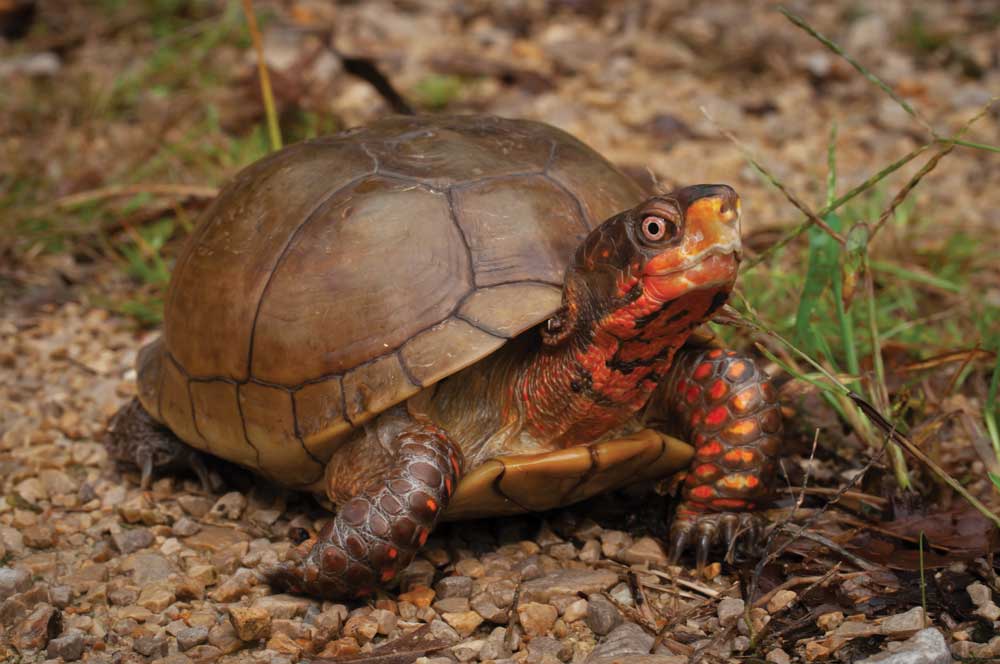With constant, quality care and dedication, your turtle can easily live more than 30 years.
Turtles are some of the most interesting reptiles. They have a hard shell (mostly) and can be aquatic, semi-aquatic or primarily land dwellers. With proper care, turtles can live more than 30 years in captivity, bringing years of enjoyment and learning for their keepers. Many can live much longer. You can find breeders who specialize in these reptiles and some, such as the red-eared slider, are available with unique colorations, or morphs. Here we present four turtles that are popular North American natives, their natural history and captive care.
Three-toed box turtle (Terrapene carolina triunguis)
The three-toed box turtle is a subspecies of the common box turtle and is found throughout much of the south central United States, including Arkansas, Louisiana, certain regions of Kansas, Oklahoma and Texas as well as Mississippi, Alabama and select areas of Georgia. The three-toed box turtle is also the official reptile of Missouri. The shell of the three-toed box turtle is domed and grows to about 5 to 7 inches in carapace length, with females the larger of the sexes. It is called the three-toed box turtle because its back feet have just three toes, versus four in other box turtles. However, because this species interbreeds with other box turtles, some speculate this may be one of the reasons that some three-toed box turtles have four toes on their rear feet.
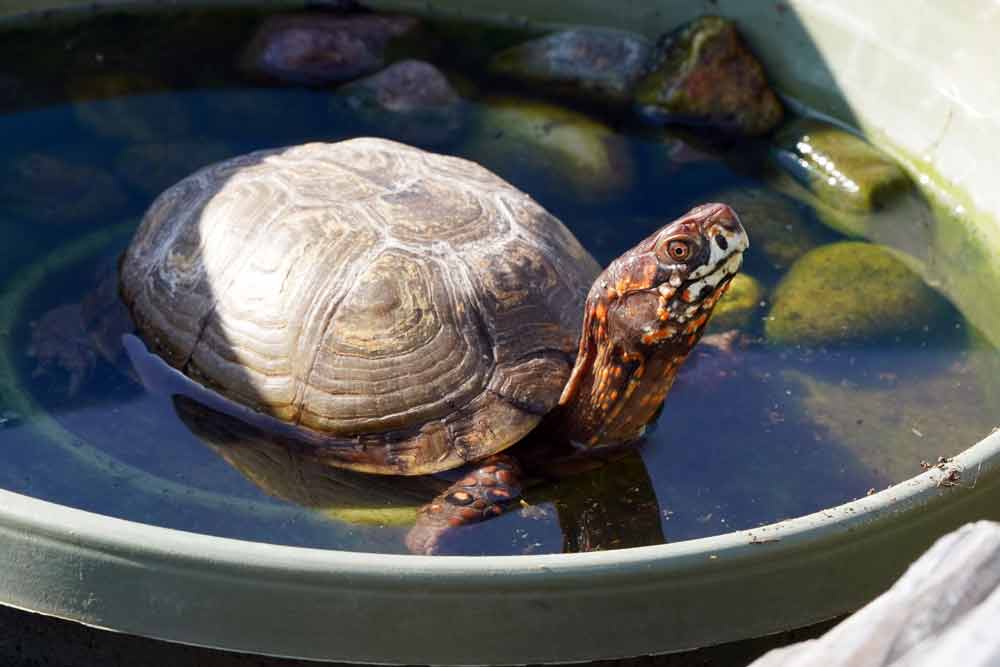
Make sure to give your turtles an occasional soak to prevent dehydration.
Enclosure
The three-toed box turtle thrives in large outdoor enclosures that are built with walls that are about 2 feet tall, with a barrier extending underground about 10 to 12 inches below the surface. This is to keep the turtle from digging under its enclosure and escaping. A 10 foot by 12 foot enclosure can safely house several box turtles. The enclosure should have ample areas for the turtle to thermoregulate in natural sunlight as well as shade and several hides to escape the heat of the sun.
Ensure the top of the enclosure is secure from predators such as raccoons, rats and others that will make easy prey of these small turtles.
Keeping these turtles outdoors is ideal, however, if you live in an area of extreme cold, a large, indoor enclosure works as well. In fact because these turtles are so small, they are ideal candidates for keeping indoors. The enclosure must be large enough for the turtle to move and roam about. A minimum five feet long by two feet wide and a foot tall will work, but bigger enclosures are better. Some reptile enclosure manufacturers offer ready built and modular turtle enclosures that can be expanded. Check out some of the custom enclosure builders as well. Ensure that the enclosure has a shallow water feature for your turtle to soak, and give your three-toed box turtle a shallow bath twice a week to ensure that it is well hydrated. Place a rough, flat rock in the enclosure that your turtle can climb atop, to help keep your turtle’s nails trimmed.
Substrate
A mixture of coconut coir and sphagnum moss with a reptile-specific soil is ideal to help with humidity in the turtle’s enclosure. These substrates can be purchased at your local reptile store, online and at reptile shows. Layer the substrate to about 6 inches for indoor enclosures and 12 to 24 inches if you are keeping your box turtle in a larger, outdoor enclosure. A humidity range of 60 to 80 percent is ideal for your indoor enclosure. Purchase a hygrometer, or a thermometer/hygrometer to keep track of the humidity/temperatures and to ensure the humidity is within the ideal range of keeping this species.
Temperature/Lighting/UVB
If you are keeping your three-toed box turtle indoors, it is imperative that it receives ample UVB light for the proper synthesis of Vitamin D3, which is required for proper bone and shell growth. You can achieve this with a mercury vapor bulb which provides UVB and heat or a dedicated UVB bulb. Each of the manufacturers of these reptile lighting systems have recommendations for your specific application. Follow them based on the size of your enclosure as well as the distance from the mounting point of the light to the surface of the enclosure.
The three-toed box turtle is a Zone 2 (UVI 0.7 to 1.0) reptile on the Ferguson Zone. It is a partial sun/occasional full sun basker. For indoor enclosures, establish a temperature gradient with the warm end at 80 degrees Fahrenheit (27 degrees Celsius) and the cool end at around 70 degrees Fahrenheit (21.1 degrees Celsius). The basking area should be about 85 degrees Fahrenheit (29.4 degrees Celsius). This can be achieved with a heat lamp positioned strategically at the appropriate distance above the basking area. For more information on proper UVB and lighting, please visit Reptilesmagazine.com/reptile-lighting-information/.
Feeding
Three-toed box turtles are omnivores and eat a variety of plant an animal matter in the wild. You can feed them the same in captivity. Feed your three-toed box turtle a high-quality commercial turtle food to ensure well-balanced nutrition. Offer them feeder insects such as night crawlers, earthworms, mealworms, superworms and crickets. Dust the insects with a high-quality reptile vitamin and calcium supplement. You can also feed them cooked lean beef and chicken. Feed them greens of the leafy variety such as kale, arugula and red leaf lettuce, and fruits such as apples and bananas.
Ideal Keeper/Handling
The three-toed box turtle is a small turtle that does best in an outdoor enclosure. Like most all turtles, they are a long-lived reptile that require special care and enclosure requirements.
Though some three-toed box turtles take handling well, others do not, so keep this in mind. Keep this information in mind if you are considering keeping one.
Eastern Box Turtle (Terrapene carolina carolina)
Eastern box turtles might be the most popular box turtles of the Terrapene genus. A subspecies of the common box turtle (Terrapene carolina) the Eastern box turtle (Terrapene carolina carolina) is found throughout much of the eastern United States, as far north as Maine, down to Texas. Although the Eastern box turtle is in the Emydidae family along with terrapins, pond turtles and mud and marsh turtles, the Eastern box turtle is found on land rather than in water. They inhabit forest floors that are moist, in wet leaf litter and dirt, open grasslands and pastures. The Eastern box turtle is protected in many ranges in which it inhabits and collecting is prohibited. They are also widely captive bred and are available via online breeders and occasionally can be found at your local reptile show, if they are permitted in your area. Please know your laws before acquiring one.
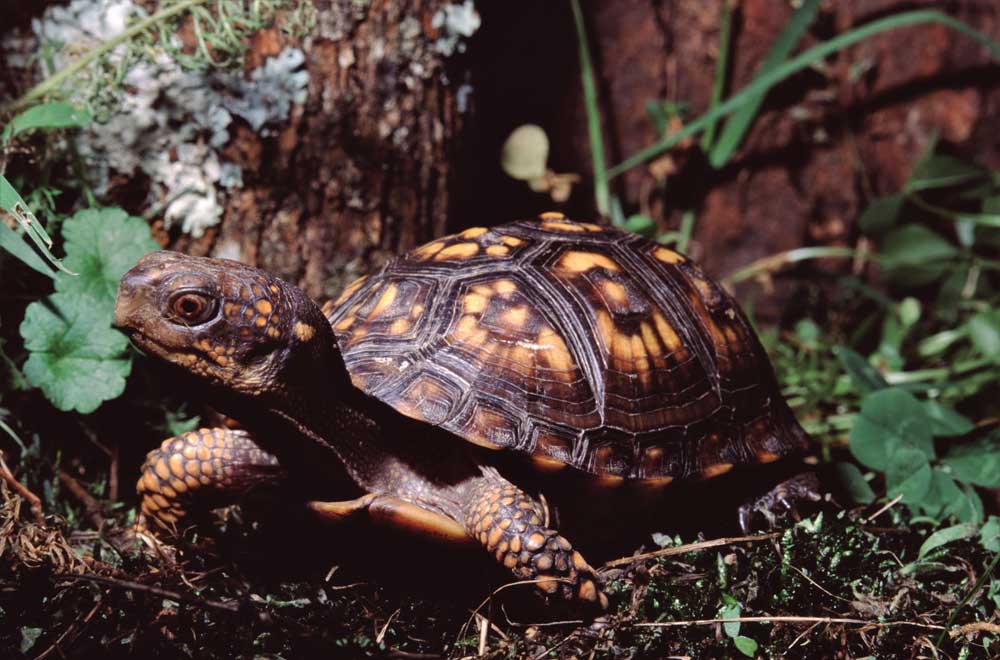
Eastern box turtles require enough substrate so they can bury themselves. Layer some nice leaf litter atop the soil. Photo by Liz Weber/Shutterstock
Enclosure
You can keep a hatchling in a 4’x2’x’1’ enclosure up until they reach about 3 to 4 years of age. Upgrade the turtle to a larger enclosure as it grows. The larger and longer the better, as they need the space to explore.
If you live in an area where temperatures don’t go below 55 degrees Fahrenheit (12.8 degrees Celsius) in the winter, consider an outdoor enclosure for a single box turtle. Several manufacturers offer these types of enclosures, and they are often modular so you can add to them as your turtle grows. These enclosures enable you to bring your box turtle outside to take advantage of natural sunlight and UVB. Your turtle needs a water bowl that is large enough to soak in and low enough to climb into. This helps to prevent dehydration. Keep the humidity between 60 and 70 percent. This can be achieved by keeping some peat moss in one end of the enclosure damp. A hygrometer is essential to ensure the humidity level are at the proper range. The other end of the terrarium should be drier. This gives your turtle the capability to move between the damp and dry sides of the terrarium. Make sure there are several hides in which the turtle can climb into or under.
Substrate
You should use a layer of about four to six inches of organic soil in the enclosure to ensure your box turtle can bury itself when the need arises. You can create your own with a combination of organic topsoil and play sand or purchase ready made soil from the major reptile product manufacturers. Because these turtles are often found hiding in leaf litter in the wild, ensure the enclosure has an ample amount of leaf litter so it can bury itself in the leaf litter as well.
Temperature/Lighting/UVB
If you are keeping your Eastern box turtle indoors, UVB lighting is absolutely essential to process calcium. The Eastern box turtle is a Zone 2 reptile on the Ferguson Zone for UVB. Choose a bulb with a Zone range UVI 0.7 – 1.0 with a maximum UVI: 1.1 – 3.0 in basking zone). It is a partial sun/occasional basker. A UVB light fixture should run the length of the enclosure and left on for 12 hours a day and then turned off. The UVB bulb should be replaced according to the manufacturer’s recommended replacement time frame. Follow the placement recommendations based on the size of your enclosure as well as the distance from the mounting point of the light to the surface of the enclosure. For more information on UVB, read the article on UVB on page 16 of this issue. The ambient temperature of the enclosure should be about 75 degrees Fahrenheit (23.9 degrees Celsius) with a basking area of about 85 to 90 degrees Fahrenheit (29.4 to 32.2 degrees Celsius)
Feeding
The Eastern box turtle is an omnivore and eats a variety of plant and animal matter. In captivity, you can feed them a variety of insects such as crickets, earthworms and mealworms as well as a variety of soft fruits such as berries, and vegetables. It is important that you also provide a high-quality commercial turtle diet available from the reptile food manufacturers to ensure your turtle receives a well-balanced and complete diet. Dust the insects with a high-quality reptile vitamin and calcium supplement and feed them a high-quality commercial turtle food as well to ensure well balanced nutrition. Ensure your turtle has fresh food each day and remove uneaten food at the end of the day, taking note of what was eaten and how much so you can adjust the feeding schedule with the right amount and types of foods.
Ideal Keeper/Handling
The Eastern box turtle grows to about six inches in carapace length and can live more than 50 years in captivity. They are a neat species to interact with and have an inquisitive demeanor. Before acquiring one, be sure to check your local laws, as Eastern box turtles, while not listed as endangered on a national level, are protected in several states. Seek out a reputable breeder who works with these reptiles and buy captive bred animals.
Ornate Box Turtle (Terrapene ornata ornata)
The ornate box turtle is a relatively small land turtle with a carapace length of about 5 to 7 inches in length and is found in habitats such as pastures, prairies and woodland areas. It is found in the Great Plains of the United States, including, but not limited to the states of Indiana, Texas, Kansas, New Mexico, Iowa, and Louisiana. It is listed as an endangered species in the state of Indiana and is the official reptile of Kansas. While they require adequate sources of drinking water, they don’t spend a lot of time near water. There are two subspecies: Terrapene ornata ornata, and the desert box turtle, Terrapene ornata luteola. Of the two, the desert box turtle thrives in arid and drier conditions than the ornate box turtle. The ornate box turtle sports a domed shell that is flat on top and is black or dark brown in coloration with yellow striped patterns on the shell. They have a hinged plastron, with males having a slightly concave plastron and females having a flat plastron.
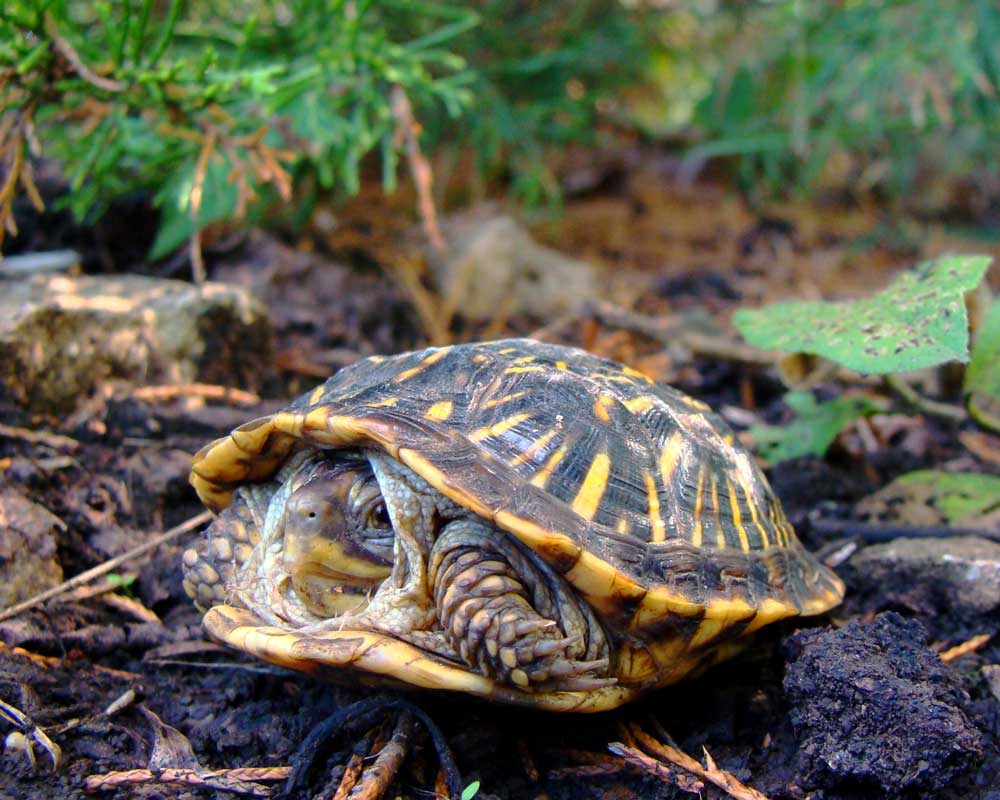
Ornate box turtles are for intermediate to advanced keepers.
Photo by Matt Jepson/Shutterstock
Enclosure
If you are keeping your turtle outdoors, house them in a turtle pen of 10 to 12 square feet with sidewalls of at least 12 to 18 inches high. These turtles are adept climbers so ensure the barrier is impassable to them. You can build your own pen (see Building an Outdoor Tortoise Pen, here, Reptilesmagazine.com/how-to-build-a-basic-outdoor-tortoise-pen/), or you can purchase a turtle pen from the major reptile enclosure manufacturers. For indoor keeping, you’ll want an enclosure of at least a similar size. Again, you can custom build one yourself to suit your aesthetic, or have one built from one of the many reptile enclosure manufacturers, or purchase a ready-made solution. The beauty of housing the ornate box turtle outdoors is it will receive all the natural sunlight that it wishes and can move from sun to shade at its leisure. The drawback of an outdoor enclosure are the myriad predators that may be lurking in your area as well as having to move your turtle indoors for the winter, depending on where you live. Make sure your turtle has adequate places to hide on both sides of the enclosure as well.
Substrate
The ideal substrate for this species is a deep, sandy soil substrate that enables the turtle to burrow in to escape heat or cold. Outdoor enclosures should have at least 12 inches of substrate, while indoor enclosures should have 8 and preferably 12 inches of substrate if possible as well as moist sphagnum moss for burrowing on the cool side of the enclosure.
Temperature/Lighting/UVB
Indoor ornate box turtle enclosures should have a cool end between 70 and 75 degrees Fahrenheit (21.1 to 23.9 degrees Celsius) and a hot spot of between 85 and 90 degrees Fahrenheit (29.4 to 32.2 degrees Celsius). The ambient temperature should be maintained at around 80 degrees Fahrenheit (26.7 degrees Celsius). You can use a spot lamp connected to a temperature controller/rheostat to achieve the right temperatures. The ornate box turtle is a Zone 2 reptile on the Ferguson Zone for UVB. It is a partial sun/occasional basker. Choose a bulb with a Zone range UVI 0.7 – 1.0 with a maximum UVI of 1.1 – 3.0 in your turtle’s basking zone. Keep this in mind when choosing a UVB light source as well as distance from the light to the basking area. For more information on reptile lighting and UVB, read the article on UVB on page 16 of this issue. Humidity levels for adults should be between 40 to 50 percent. Hatchlings and juveniles should be maintained with humidity levels between 60 to 70 percent.
Feeding
In the wild, the ornate box turtle feeds on a variety of animal and plant matter, including worms, grasshoppers, caterpillars and even dead animal matter. They also feed on berries, grasses, fruits and other greens. In captivity, ensure your ornate box turtle receives a varied diet of insects such as crickets, dubia roaches, mealworms, earthworms and grasshoppers (if they are available in your area). Vegetable matter should include berries, mushrooms, mustard greens, dandelion greens and other leafy greens. Dust the insects with a high-quality reptile vitamin and calcium supplement and feed them a high-quality commercial turtle food as well to ensure well-balanced nutrition.
Ideal Keeper/Handling
The ornate box turtle is an ideal reptile for intermediate keepers. They require large enclosures and a varied diet to ensure their good health. When searching for one, find a reputable breeder of this species, and check your local laws with regard to keeping them as they may be protected in your state and/or may require permits. This turtle is an active species and will explore every inch of their enclosure, so make sure you house them in an enclosure that will keep them exploring and mix it up with new hides, rocks and other decor that will keep them challenged.
Red-eared Slider (Trachemys scripta elegans)
The red-eared slider (Trachemys scripta elegans) is hands down the most popular turtle among reptile keepers. Endearing and intelligent, and with the capability to live more than 30 years in captivity, the semi-aquatic red-eared slider has for decades been the most accessible turtle in the reptile hobby. That popularity though, has a downside as well. Because of the sheer volume of these animals being captive bred over the decades, they are sometimes sold and traded like trinkets, something that is illegal in many jurisdictions and the laws should be enforced.
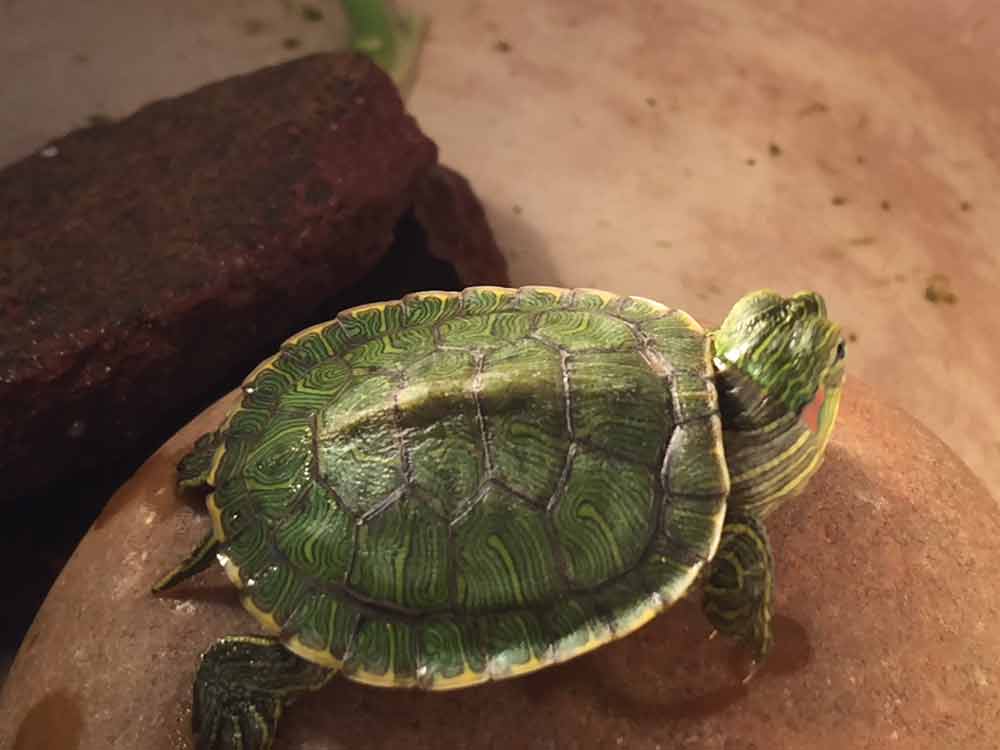
Red eared slider hatchling
Nearly every Chinatown in the United States has red-eared slider hatchlings for sale, often for less than $20. Because of their popularity, you can find these turtles in bodies of water and ponds throughout much of the United States in regions that they are not native. Check your local laws before acquiring one of these turtles, as not all municipalities in the United States allow the keeping of them. The upside is that these beautiful chelonians are very hardy and keeping them does not have to be complicated. Native to the Midwestern United States, and now found in as far flung areas as Japan and the Philippines, the red-eared slider is so named due to the red stripe around where its external ears would be. This semi-aquatic turtle is on the large size, growing to 12 to 15 inches in carapace length, with average lengths of about 8 to 10 inches carapace length. As they are large turtles, adults require very large enclosures.
Enclosure
Hatchlings larger than 4 inches carapace length can be kept in a 36”x18”x18 enclosure with enough water in the enclosure for them to swim about. They will also require a place to haul out and completely dry off. This area will also serve as a basking platform. Hatchlings will quickly outgrow enclosures of this size, so plan accordingly.
If you choose to keep your adult red-eared slider in an aquarium, a 150 to 300 gallon aquarium will provide the room for these large turtles to move about and explore. Ideally, you will want to keep this species in an outdoor pond with a minimum size of 10’ x 12’ and 30 inches water depth. Waterland Tubs makes an enclosure that has a volume of 200 gallons and is 3/4 water and 1/4 land that could work for an adult red-eared slider. These are big turtles as adults and they require large spaces.
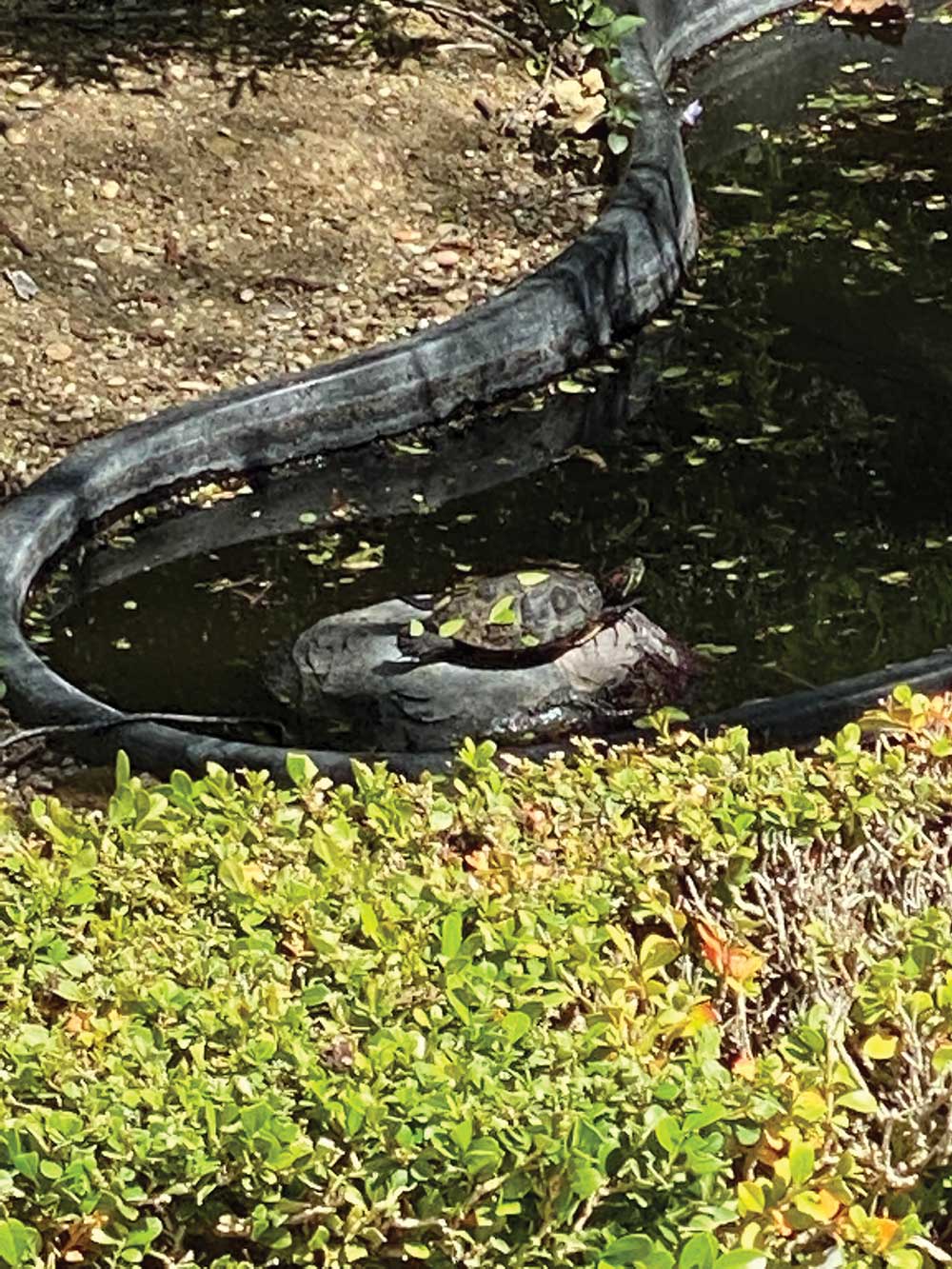
Red-eared sliders do well in outdoor ponds.
Substrate
River rock and sand are the ideal substrates for these turtles. Ensure that the river rock is too large for the turtle to ingest. Sand shouldn’t be fine, but rather should have larger grains so it doesn’t get into the water column and then into your water filter, mucking up its capabilities. You can combine both the large river rock with the sand for a balanced approach. Purchase a water filter for your turtle’s enclosure that is at a minimum rated to filter the amount of water in the enclosure. Water filters are rated at gallons per hour. Consider purchasing a water filter that can filter out twice the amount of water that is in the enclosure. Canister filters are good solutions for aquatic and semi-aquatic turtles. Red-eared sliders are messy–not only do they feed in the water, they defecate in it as well. Choose a quality canister filter and maintain it.
Temperature/Lighting/UVB
Near my home in Southern California, there is a pond where there are dozens of illegally released red-eared sliders. I often see them on logs, or just on the banks of the pond. These turtles like to bask and take full advantage of the sun. As such, full spectrum lighting is imperative to ensure their good health and proper synthesizing of vitamin D.
For your hatchling and juvenile red-eared slider, acquire a combination light kit that combines a heat lamp and a UVB bulb. In the wild, the red-eared slider lives in mostly full sun and partial sun. The red-eared slider is a Zone 3 reptile on the Ferguson Zone. It is a partial/open sun basker. Choose a light with a Zone range UVI 1.0 to 2.6 with a maximum UVI: 2.9 to 7.4. Water temperatures in the enclosure should be kept between 75 and 85 degrees Fahrenheit (23.9 to 29.4 degrees Celsius). Place the lighting over one of the basking platforms. Purchase a submersible water heater appropriate for the number of gallons of water in your turtle’s enclosure.
Feeding
Feed your red-eared slider a high-quality commercial turtle food for well-balanced nutrition and supplement that with crickets, earthworms, superworms, and leafy green vegetables such as bok choy and collard greens. Dust the insects with a high-quality reptile vitamin and calcium supplement. Place live rosy red minnows or small shiners (if available in your area) into their habitat so they can hunt like they do in the wild. Do not feed them live goldfish or prey items caught in the wild.
Ideal Keeper/Handling
While the red-eared slider is the most popular turtle among reptile keepers and one of the most popular pet reptiles, they require specialized care and very specific enclosure requirements.
If you have the means, an outdoor pond is the best enclosure for adult red-eared sliders. These turtles live a long time and can bring decades of enjoyment for those who keep them.

